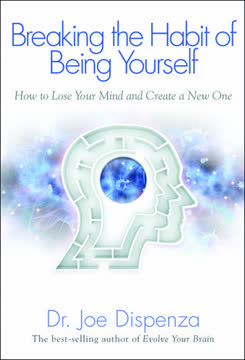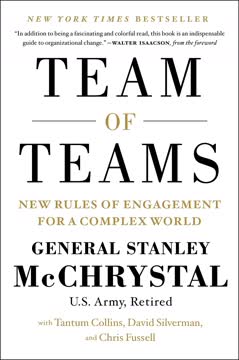نکات کلیدی
1. تفکر سیستمی: رویکردی جامع برای حل مسائل
"تفکر سیستمی یک رشته برای دیدن کلها است. این یک چارچوب برای دیدن روابط متقابل به جای اشیاء، و برای دیدن الگوهای تغییر به جای 'عکسهای ثابت' است."
گسترش دیدگاهها. تفکر سیستمی رویکردی قدرتمند برای درک و حل مسائل پیچیده است که با نگاهی به تصویر بزرگتر انجام میشود. به جای تمرکز بر رویدادهای جداگانه یا اجزای فردی، به بررسی ارتباطات و روابط درون یک سیستم میپردازد. این دیدگاه جامع به ما این امکان را میدهد که الگوهای زیرین را شناسایی کنیم، پیامدهای بلندمدت را پیشبینی کنیم و راهحلهای مؤثرتری توسعه دهیم.
اصول کلیدی:
- ارتباط متقابل: همه چیز به همه چیز دیگر مرتبط است
- ترکیب: درک کل سیستم به جای فقط اجزای آن
- حلقههای بازخورد: شناسایی چگونگی تأثیرگذاری اقدامات و واکنشها بر یکدیگر
- ظهور: مشاهده چگونگی بروز رفتارهای پیچیده از تعاملات ساده
با پذیرش تفکر سیستمی، میتوانیم بهتر در پیچیدگیهای دنیای خود، از روابط شخصی تا چالشهای جهانی، حرکت کنیم. این رویکرد ما را تشویق میکند که فراتر از علائم فوری نگاه کنیم و به ریشههای مشکلات بپردازیم، که منجر به راهحلهای پایدارتر و مؤثرتر میشود.
2. عناصر، ارتباطات و هدف: اجزای اصلی سیستمها
"سیستمها بیشتر از مجموع اجزای خود هستند؛ آنها محصول تعاملات اجزای خود هستند."
اجزای اصلی. هر سیستم، چه طبیعی و چه ساخته دست بشر، از سه جزء اساسی تشکیل شده است: عناصر، ارتباطات و هدف (یا عملکرد). عناصر، بخشهای ملموس یا ناملموس یک سیستم هستند، مانند افراد، اشیاء یا ایدهها. ارتباطات، روابط و جریانهای اطلاعاتی هستند که این عناصر را به هم متصل میکنند. هدف (یا عملکرد) هدف یا دلیل وجودی سیستم است.
درک سیستمها:
- عناصر: شناسایی اجزای کلیدی درون سیستم
- ارتباطات: ترسیم چگونگی تعامل این اجزا و تأثیرگذاری بر یکدیگر
- هدف: تعیین هدف کلی یا عملکرد سیستم
با تحلیل این سه جنبه، میتوانیم درک عمیقتری از نحوه عملکرد سیستمها به دست آوریم و مناطق بالقوه برای بهبود یا مداخله را شناسایی کنیم. این چارچوب به ما کمک میکند تا فراتر از مشاهدات سطحی برویم و راهحلهای جامعتری برای مسائل پیچیده توسعه دهیم.
3. حلقههای بازخورد: نیروی محرکه رفتار سیستم
"یک حلقه بازخورد زمانی شکل میگیرد که تغییرات در یک موجودی بر جریانهای ورودی یا خروجی همان موجودی تأثیر بگذارد."
دینامیک سیستم. حلقههای بازخورد مکانیزمهایی هستند که رفتار سیستم را در طول زمان هدایت میکنند. دو نوع اصلی حلقههای بازخورد وجود دارد: تقویتکننده و متعادلکننده. حلقههای تقویتکننده تغییرات را تقویت میکنند و منجر به رشد یا کاهش نمایی میشوند. حلقههای متعادلکننده تغییرات را خنثی میکنند و ثبات یا تعادل را درون یک سیستم حفظ میکنند.
مفاهیم کلیدی:
- حلقههای تقویتکننده: تغییر را تقویت میکنند (مانند بهره مرکب، رشد جمعیت)
- حلقههای متعادلکننده: تغییر را خنثی میکنند (مانند ترموستات، روابط شکارچی-شکار)
- تأخیرها: تأخیر زمانی بین اقدامات و اثرات آنها درون یک سیستم
درک حلقههای بازخورد برای پیشبینی رفتار سیستم و شناسایی نقاط مداخله مؤثر بسیار مهم است. با شناسایی این الگوها، میتوانیم راهحلهای هدفمندتر و پایدارتر برای مسائل پیچیده طراحی کنیم و از پیامدهای ناخواسته جلوگیری کنیم و تغییرات مثبت ایجاد کنیم.
4. گلوگاهها و نقاط اهرمی: شناسایی مناطق کلیدی برای تغییر
"نقطه بیشترین تراکم که باعث تأخیر در یک سیستم میشود."
مداخله استراتژیک. گلوگاهها محدودیتهایی هستند که عملکرد کلی یک سیستم را محدود میکنند، در حالی که نقاط اهرمی مناطقی هستند که تغییرات کوچک میتوانند منجر به بهبودهای قابل توجهی شوند. شناسایی این مناطق کلیدی برای حل مؤثر مسائل و بهینهسازی سیستم بسیار حیاتی است.
استراتژیهای بهبود:
- شناسایی گلوگاهها: پیدا کردن مهمترین محدودیتها در سیستم
- شناسایی نقاط اهرمی: جستجو برای مناطقی که تغییرات کوچک میتوانند تأثیرات بزرگی داشته باشند
- اعمال قانون 80/20: تمرکز بر 20% تلاشهایی که 80% نتایج را به ارمغان میآورند
- در نظر گرفتن مبادلات: شناسایی اینکه بهبود یک حوزه ممکن است بر دیگران تأثیر بگذارد
با تمرکز بر گلوگاهها و نقاط اهرمی، میتوانیم منابع را به طور مؤثرتری تخصیص دهیم و راهحلهای تأثیرگذاری ایجاد کنیم. این رویکرد به ما کمک میکند تا از هدر دادن زمان و انرژی بر روی اصلاحات سطحی جلوگیری کنیم و به جای آن به ریشههای مشکلات سیستمی بپردازیم.
5. انتقال از تفکر خطی به تفکر سیستمی: غلبه بر موانع ذهنی
"مسائل نمیتوانند با همان سطح تفکری که آنها را ایجاد کرده است، حل شوند."
تغییر پارادایم. حرکت از تفکر خطی و علت و معلولی به تفکر سیستمی نیاز به غلبه بر چندین مانع ذهنی دارد. این تغییر شامل شناسایی ارتباطات مشکلات، پذیرش پیچیدگی و به چالش کشیدن فرضیات ما درباره نحوه عملکرد جهان است.
غلبه بر موانع:
- اجتناب از ذهنیت اصلاح سریع: به دنبال راهحلهای بلندمدت و پایدار باشید
- پذیرش پیچیدگی: شناسایی اینکه راهحلهای ساده ممکن است ریشههای مشکلات را حل نکنند
- به چالش کشیدن فرضیات: سؤال کردن از روشهای تثبیت شده تفکر و حل مسائل
- پرورش صبر: درک اینکه تغییرات سیستمی زمان میبرد تا خود را نشان دهند
با پذیرش تفکر سیستمی، میتوانیم رویکردهای دقیقتر و مؤثرتری برای حل مسائل توسعه دهیم. این تغییر در دیدگاه به ما این امکان را میدهد که فراتر از علائم فوری نگاه کنیم و به ریشههای مشکلات بپردازیم، که منجر به راهحلهای پایدارتر و مؤثرتر میشود.
6. به کارگیری تفکر سیستمی در مسائل اجتماعی: بیخانمانی به عنوان یک مطالعه موردی
"بسیاری از اوقات ما دلیل تداوم سیستمی هستیم که میخواهیم تغییر دهیم—البته به طور ناخواسته."
چالشهای اجتماعی پیچیده. به کارگیری تفکر سیستمی در مسائل اجتماعی مانند بیخانمانی، شبکه پیچیدهای از عوامل مؤثر بر این مشکل را نمایان میسازد. با بررسی ارتباطات بین ذینفعان مختلف، سیاستها و ساختارهای اجتماعی، میتوانیم راهحلهای جامعتر و مؤثرتری توسعه دهیم.
ملاحظات کلیدی:
- شناسایی ذینفعان: درک دیدگاههای همه طرفهای درگیر
- ترسیم دینامیک سیستم: بررسی چگونگی تأثیرگذاری عوامل مختلف بر یکدیگر
- شناسایی پیامدهای ناخواسته: پیشبینی نتایج منفی بالقوه
- همراستایی مشوقها: ایجاد راهحلهایی که به نفع همه ذینفعان باشد
تفکر سیستمی به ما کمک میکند تا فراتر از اصلاحات کوتاهمدت برویم و به ریشههای مسائل اجتماعی بپردازیم. با در نظر گرفتن کل سیستم، میتوانیم راهحلهای پایدارتر و عادلانهتری توسعه دهیم که نیازهای همه ذینفعان درگیر را برآورده کند.
7. تفکر سیستمی در عمل: ابتکار Less-to-Landfill
"بدون اتخاذ رویکرد تفکر سیستمی، این ابتکار هرگز موفق نمیشد."
کاربرد در دنیای واقعی. ابتکار Less-to-Landfill در Sabre Holdings قدرت تفکر سیستمی را در حل چالشهای پیچیده سازمانی نشان میدهد. با ترسیم سیستمهای مدیریت زباله، شناسایی حلقههای بازخورد و بهروزرسانی مداوم رویکرد خود، این شرکت به بهبودهای چشمگیری در انحراف زباله دست یافت.
درسهای کلیدی:
- ترسیم سیستم: شناسایی زیرسیستمها و ارتباطات آنها
- استفاده از حلقههای بازخورد: نظارت و تنظیم مداوم بر اساس نتایج
- درگیر کردن ذینفعان: مشارکت همه سطوح سازمان در فرآیند تغییر
- پذیرش تکرار: آمادگی برای تطبیق و اصلاح راهحلها در طول زمان
این مطالعه موردی نشان میدهد که چگونه تفکر سیستمی میتواند منجر به بهبودهای قابل توجهی در عملکرد و پایداری سازمانی شود. با اتخاذ رویکردی جامع و بهرهگیری از حلقههای بازخورد، شرکتها میتوانند به اهداف بلندپروازانه دست یابند و تغییرات مثبت ماندگاری ایجاد کنند.
8. کاربرد شخصی: بهبود کار و زندگی از طریق تفکر سیستمی
"شما بر روی کسی تأثیر دارید. آنها نیز بر دیگران تأثیر میگذارند. و این یک واکنش زنجیرهای را آغاز میکند."
تأثیر فردی. تفکر سیستمی تنها برای سازمانها یا مسائل جهانی نیست؛ بلکه میتواند در توسعه شخصی و حرفهای نیز به کار گرفته شود. با شناسایی ارتباطات در زندگی و کار خود، میتوانیم تصمیمات آگاهانهتری بگیریم و تغییرات مثبتی ایجاد کنیم.
کاربردهای عملی:
- تحلیل روابط شخصی: درک چگونگی تأثیرگذاری و تأثیرپذیری از دیگران
- بهبود فرآیندهای کاری: شناسایی گلوگاهها و نقاط اهرمی در جریان کار خود
- تعیین اهداف واقعبینانه: در نظر گرفتن تأثیرات بلندمدت و پیامدهای ناخواسته بالقوه
- پرورش آگاهی: توجه به الگوها و حلقههای بازخورد در زندگی روزمره
به کارگیری تفکر سیستمی در زندگی شخصی میتواند منجر به تجربیات متعادلتر، رضایتبخشتر و تأثیرگذارتر شود. با شناسایی جایگاه خود درون سیستمهای بزرگتر، میتوانیم انتخابهای آگاهانهتری داشته باشیم و به تغییرات مثبت در جوامع و فراتر از آن کمک کنیم.
آخرین بهروزرسانی::
FAQ
1. What is "Think In Systems" by Zoe McKey about?
- Introduction to Systems Thinking: The book introduces the concept of systems thinking, explaining how it differs from linear, cause-effect thinking and why it’s essential for understanding complex problems.
- Practical Application: It provides both theoretical foundations and practical tools for applying systems thinking to personal, professional, and societal challenges.
- Step-by-Step Guidance: Readers are guided through the basics of systems, feedback loops, bottlenecks, leverage points, and real-world examples to help them adopt a systems mindset.
- Accessible Language: Zoe McKey aims to make the discipline approachable, avoiding jargon and using relatable stories and exercises.
2. Why should I read "Think In Systems" by Zoe McKey?
- Solve Complex Problems: The book equips readers with tools to analyze and address complex, recurring issues in life, work, and society that linear thinking can’t solve.
- Improve Decision-Making: By understanding systems, readers can make more informed, strategic decisions and avoid short-term fixes that create long-term problems.
- Personal and Professional Growth: Systems thinking can be applied to self-improvement, relationships, business, and social change, making it widely relevant.
- Beginner-Friendly Approach: It’s designed for those new to systems thinking, offering clear explanations, practical exercises, and real-life examples.
3. What are the key takeaways from "Think In Systems" by Zoe McKey?
- Everything is Interconnected: Systems thinking reveals how elements, interconnections, and purposes shape outcomes in any system.
- Focus on Patterns and Relationships: Instead of just events, look for underlying patterns, feedback loops, and structures that drive behavior.
- Identify Bottlenecks and Leverage Points: Lasting change comes from addressing root constraints and using leverage for maximum impact.
- Shift from Symptom to Cause: Effective problem-solving requires digging deeper than surface symptoms to find and address core issues.
4. How does Zoe McKey define systems thinking in "Think In Systems"?
- Art and Science of Understanding: Systems thinking is described as the art and science of making reliable inferences about behavior by understanding underlying structures.
- Beyond Linear Thinking: It moves beyond simple cause-effect logic to consider circular causality, feedback loops, and dynamic relationships.
- Holistic Perspective: The approach emphasizes synthesis—seeing the whole system and how its parts interact, rather than just analyzing components in isolation.
- Practical Problem-Solving: Systems thinking is positioned as a practical toolkit for mapping, diagnosing, and improving real-world systems.
5. What are the main elements and concepts of systems thinking according to "Think In Systems"?
- Elements, Interconnections, Purpose: Every system consists of elements (actors), interconnections (relationships), and a function or purpose.
- Stocks and Flows: Systems have stocks (quantities that can be measured) and flows (rates of change), which interact over time.
- Feedback Loops: Reinforcing (amplifying) and balancing (stabilizing) feedback loops are central to system behavior.
- Delays and Emergence: Delays in perception, response, and delivery can cause oscillations, while emergence describes how complex outcomes arise from simple interactions.
6. How does "Think In Systems" by Zoe McKey explain feedback loops and their importance?
- Reinforcing Loops: These amplify changes, leading to growth or decline (e.g., compounding interest, population growth).
- Balancing Loops: These stabilize systems, seeking equilibrium (e.g., thermostat regulation, predator-prey balance).
- Shifting Dominance: System behavior often results from the interplay and shifting dominance between reinforcing and balancing loops.
- Practical Examples: The book uses relatable examples like bank accounts, relationships, and business cycles to illustrate feedback loops in action.
7. What is the Iceberg Model in "Think In Systems" and how can it be used?
- Four Levels of Analysis: The model distinguishes between events (visible), patterns (trends), structures (causes), and mental models (beliefs/values).
- Digging Deeper: It encourages looking below the surface of problems to identify recurring patterns, underlying structures, and root mental models.
- Practical Exercise: Readers are guided to apply the model to personal or societal issues, helping them move from symptom management to systemic solutions.
- Broader Perspective: The Iceberg Model helps avoid quick fixes by revealing the deeper causes of persistent problems.
8. How does "Think In Systems" by Zoe McKey suggest identifying and addressing bottlenecks and leverage points?
- Theory of Constraints: Every system has a bottleneck—the tightest constraint limiting performance; improvement requires focusing on this point.
- Leverage for Maximum Impact: Leverage points are places in a system where small changes can produce significant results (e.g., changing rules, improving information flow).
- Pareto Principle: The 80/20 rule is highlighted—most results come from a small portion of effort, so focus on high-leverage actions.
- Iterative Process: The book recommends a cycle of identifying bottlenecks, applying leverage, measuring feedback, and repeating for continuous improvement.
9. What are common obstacles to adopting systems thinking, according to Zoe McKey?
- Linear Thinking Habits: People default to quick fixes, symptom treatment, and shallow analysis, missing deeper systemic causes.
- Fear of Mistakes: Organizations and individuals often avoid change due to fear of visible errors, especially omission errors (failing to act).
- Lack of Awareness and Resources: Systems thinking is a relatively new discipline, often seen as complex or inaccessible due to jargon.
- Resistance to Change: Societal, organizational, and personal inertia make it hard to shift from established ways of thinking and acting.
10. How does "Think In Systems" by Zoe McKey recommend applying systems thinking to everyday and complex problems?
- Visual Mapping: Start by mapping the system visually—identify elements, interconnections, and feedback loops.
- Behavior-Over-Time Graphs: Use graphs to track how problems and solutions evolve, revealing patterns and delays.
- Focus on Ecosystems: Analyze the broader context and relationships, not just isolated events or actors.
- Iterative Problem-Solving: Develop clear statements of the core problem, identify structures and mental models, and design interventions targeting root causes.
11. What are some real-world examples and case studies used in "Think In Systems" by Zoe McKey?
- Personal Life: Examples include managing finances, improving relationships, and self-development using systems thinking tools.
- Business and Organizations: The Sabre Holdings waste diversion initiative demonstrates mapping feedback loops and leveraging culture for sustainability.
- Social Issues: The book analyzes homelessness, drug policy, and education, showing how conflicting subsystem goals can undermine system-wide change.
- Environmental Problems: Case studies like pesticide use and snowplow management illustrate unintended consequences and the need for systemic solutions.
12. What are the best quotes from "Think In Systems" by Zoe McKey and what do they mean?
- "Everything is interconnected." – Emphasizes the core systems thinking principle that no element exists in isolation; all parts influence each other.
- "To solve problems long term, you need to focus on patterns, not just events." – Encourages looking beyond immediate issues to recurring trends and structures.
- "The real goal of systems thinking as a discipline is to help you understand and address system problems." – Highlights the practical, solution-oriented nature of the approach.
- "You can borrow the well-designed systems of the world and use them in your life." – Suggests that proven models (like supply and demand) can be adapted for personal improvement.
- "Systems thinking will change the way you analyze your life." – Underlines the transformative potential of adopting a systems perspective for personal and professional growth.
نقد و بررسی
کتاب تفکر در سیستمها نظرات متنوعی را به خود جلب کرده و امتیازاتی بین ۱ تا ۵ ستاره دریافت کرده است. برخی از خوانندگان این کتاب را به عنوان مقدمهای خوب برای تفکر سیستمی میدانند و به خاطر دسترسی آسان و مثالهای عملی آن ستایش میکنند. در مقابل، برخی دیگر آن را بسیار ابتدایی، با ویرایش ضعیف و فاقد عمق لازم انتقاد میکنند. نظرات مثبت بر ارزش این کتاب برای مبتدیان و توانایی آن در ارائهی یک نمای کلی از موضوع تأکید دارند. اما نظرات منفی به اشتباهات واقعی، نوشتار ساده و کمبود محتوای قابل توجه اشاره میکنند. به طور کلی، به نظر میرسد این کتاب بیشتر برای کسانی که تازه با تفکر سیستمی آشنا میشوند مناسب است، اما ممکن است خوانندگان با تجربهتر را ناامید کند.
Similar Books














